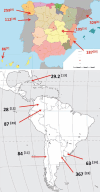[Epidemiology of myasthenia gravis in the Iberian Peninsula and Latin America]
- PMID: 36631965
- PMCID: PMC10364038
- DOI: 10.33588/rn.7602.2021201
[Epidemiology of myasthenia gravis in the Iberian Peninsula and Latin America]
Abstract
Introduction: Although today we live in a globalised world, the ties established between the Iberian Peninsula and the countries of Latin America are particularly strong, with important migratory flows. This connection may condition the development of diseases that involve a genetic influence, which may in turn be modulated by various environmental factors. The aim of this review is to determine the descriptive epidemiology of myasthenia gravis in the Iberian Peninsula and in Latin America.
Development: A literature search was conducted in Medline, LILACS and Google Scholar for the different countries of interest using the terms 'prevalence', 'incidence', 'epidemiology' and 'myasthenia gravis'. The methodology and quality were reviewed, and descriptive data about the study population as well as data on prevalence were extracted.
Conclusions: Many countries lack epidemiological studies on myasthenia gravis and in others the data reported focus on one referral hospital, making it difficult to compare prevalence between countries. In the Iberian Peninsula, the prevalence is consistently above 100 cases x 106 inhabitants, the highest figures being found in the area of Osona (Barcelona) and in the province of Ourense. In Latin America, much lower prevalence figures are reported, generally below 100 x 106 inhabitants. There is a predominance of females in the early-onset forms (<50 years) and a clear increase in prevalence in the elderly population, especially in the very late onset forms (>65 years), where it is more frequent in men.
Title: Epidemiología de la miastenia grave en la península ibérica y Latinoamérica.
Introducción. Aunque hoy en día vivimos en un mundo globalizado, los vínculos establecidos entre la península ibérica y los países de Latinoamérica son especialmente fuertes y con importantes flujos migratorios. Esta conexión puede condicionar la presentación de enfermedades que reconozcan una influencia genética, la cual puede ser modulada por diversos factores medioambientales. El objetivo de esta revisión es conocer la epidemiología descriptiva de la miastenia grave en la península ibérica y en Latinoamérica. Desarrollo. Se realizó una búsqueda bibliográfica en Medline, en LILACS y en Google Scholar para los diferentes países de interés con los términos ‘prevalence’, ‘incidence’, ‘epidemiology’ y ‘myasthenia gravis’. Se revisó la metodología y la calidad, y se extrajeron datos descriptivos de la población estudiada, así como los datos de prevalencia. Conclusiones. Muchos países carecen de estudios epidemiológicos sobre la miastenia grave, y en otros, los datos comunicados se centran en un hospital de referencia, lo que hace difícil la comparación de la prevalencia entre los diferentes países. En la península ibérica, la prevalencia es constantemente superior a 100 casos × 106 habitantes, con las cifras más altas correspondientes a la comarca de Osona (Barcelona) y a la provincia de Ourense. En Latinoamérica se registran cifras mucho menores de prevalencia, generalmente inferiores a 100 × 106 habitantes. Se constata un predominio femenino en las formas de inicio precoz (<50 años) y un claro aumento de la prevalencia en la población anciana, sobre todo en las formas de inicio muy tardío (>65 años), en las que es más frecuente en los varones.
Conflict of interest statement
Conflicto de intereses: Los autores declaran no tener conflictos de interés.
Figures

Similar articles
-
Prevalence of myasthenia gravis in the Catalan county of Osona.Neurologia. 2017 Jan-Feb;32(1):1-5. doi: 10.1016/j.nrl.2014.09.007. Epub 2014 Nov 11. Neurologia. 2017. PMID: 25449965 English, Spanish.
-
Epidemiology of myasthenia gravis in the province of Ourense (Galicia, Spain).Neurologia (Engl Ed). 2023 Mar;38(2):75-81. doi: 10.1016/j.nrleng.2020.06.013. Epub 2022 Mar 3. Neurologia (Engl Ed). 2023. PMID: 35249845
-
[Epidemiology of migraine in Spain and Latin America].Rev Neurol. 2020 Aug 1;71(3):110-118. doi: 10.33588/rn.7103.2019266. Rev Neurol. 2020. PMID: 32672349 Spanish.
-
[Epidemiology of epilepsy in Spain and Latin America].Rev Neurol. 2018 Oct 1;67(7):249-262. Rev Neurol. 2018. PMID: 30232798 Review. Spanish.
-
Epidemiology of myasthenia gravis in Ontario, Canada.Neuromuscul Disord. 2016 Jan;26(1):41-6. doi: 10.1016/j.nmd.2015.10.009. Epub 2015 Oct 27. Neuromuscul Disord. 2016. PMID: 26573434
Cited by
-
Clinical and Serological Profile of Myasthenia Gravis in the O'Higgins Region of Chile: A Regional Study.Cureus. 2025 Jul 26;17(7):e88829. doi: 10.7759/cureus.88829. eCollection 2025 Jul. Cureus. 2025. PMID: 40873839 Free PMC article.
-
[Prevalence of myasthenia gravis in Colombia. Reply].Rev Neurol. 2023 Apr 1;76(7):247-248. doi: 10.33588/rn.7607.2023078. Rev Neurol. 2023. PMID: 36973890 Free PMC article. Spanish.
-
[Prevalence of myasthenia gravis in Colombia].Rev Neurol. 2023 Apr 1;76(7):247. doi: 10.33588/rn.7607.2023067. Rev Neurol. 2023. PMID: 36973889 Free PMC article. Spanish.
-
Association between myasthenia gravis and Alzheimer's disease.Rev Neurol. 2024 Jan 16;78(2):41-46. doi: 10.33588/rn.7802.2023120. Rev Neurol. 2024. PMID: 38223947 Free PMC article. English, Spanish.
References
-
- Gilhus NE. Myasthenia gravis. N Engl J Med. 2016;375:2570–81. - PubMed
-
- Gilhus NE, Verschuuren JJ. Myasthenia gravis:subgroup classification and therapeutic strategies. Lancet Neurol. 2015;14:1023–36. - PubMed
-
- McGrogan A, Sneddon S, De Vries CS. The incidence of myasthenia gravis:a systematic literature review. Neuroepidemiology. 2010;34:171–83. - PubMed
-
- García-Martín G, Serrano-Castro PJ. Epidemiología de la epilepsia en España y Latinoamérica. Rev Neurol. 2018;67:249–62. - PubMed
Publication types
MeSH terms
LinkOut - more resources
Full Text Sources
Medical

